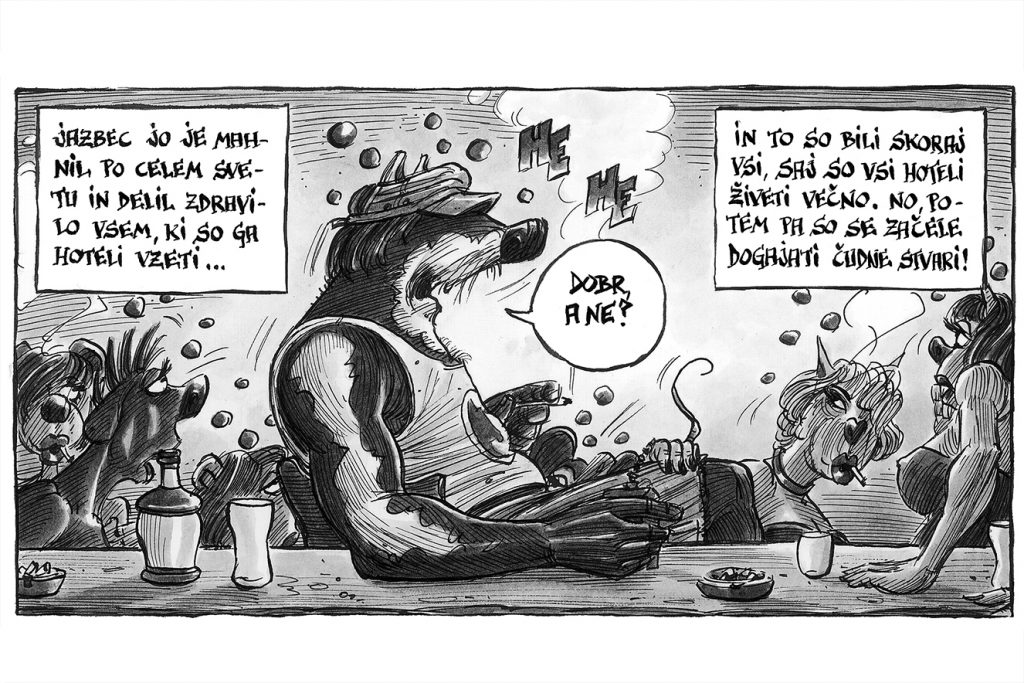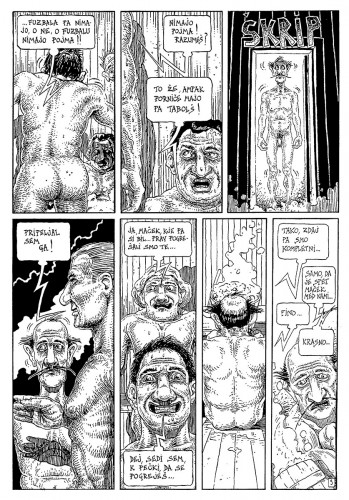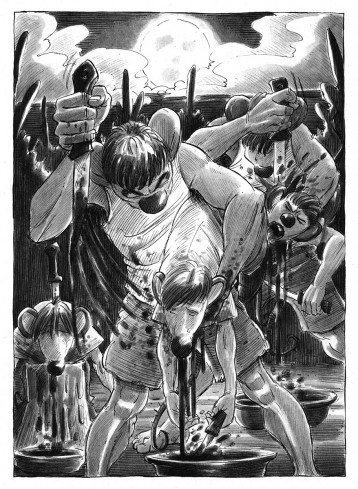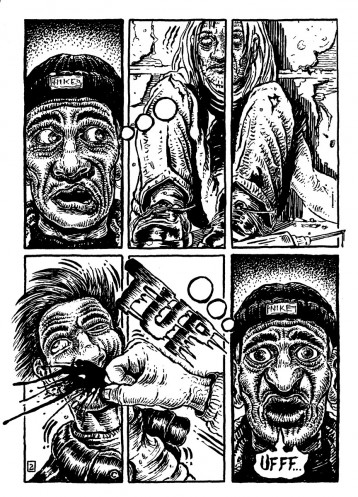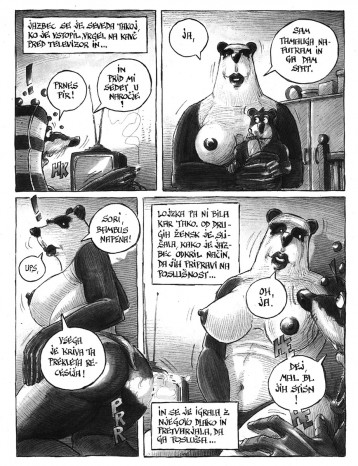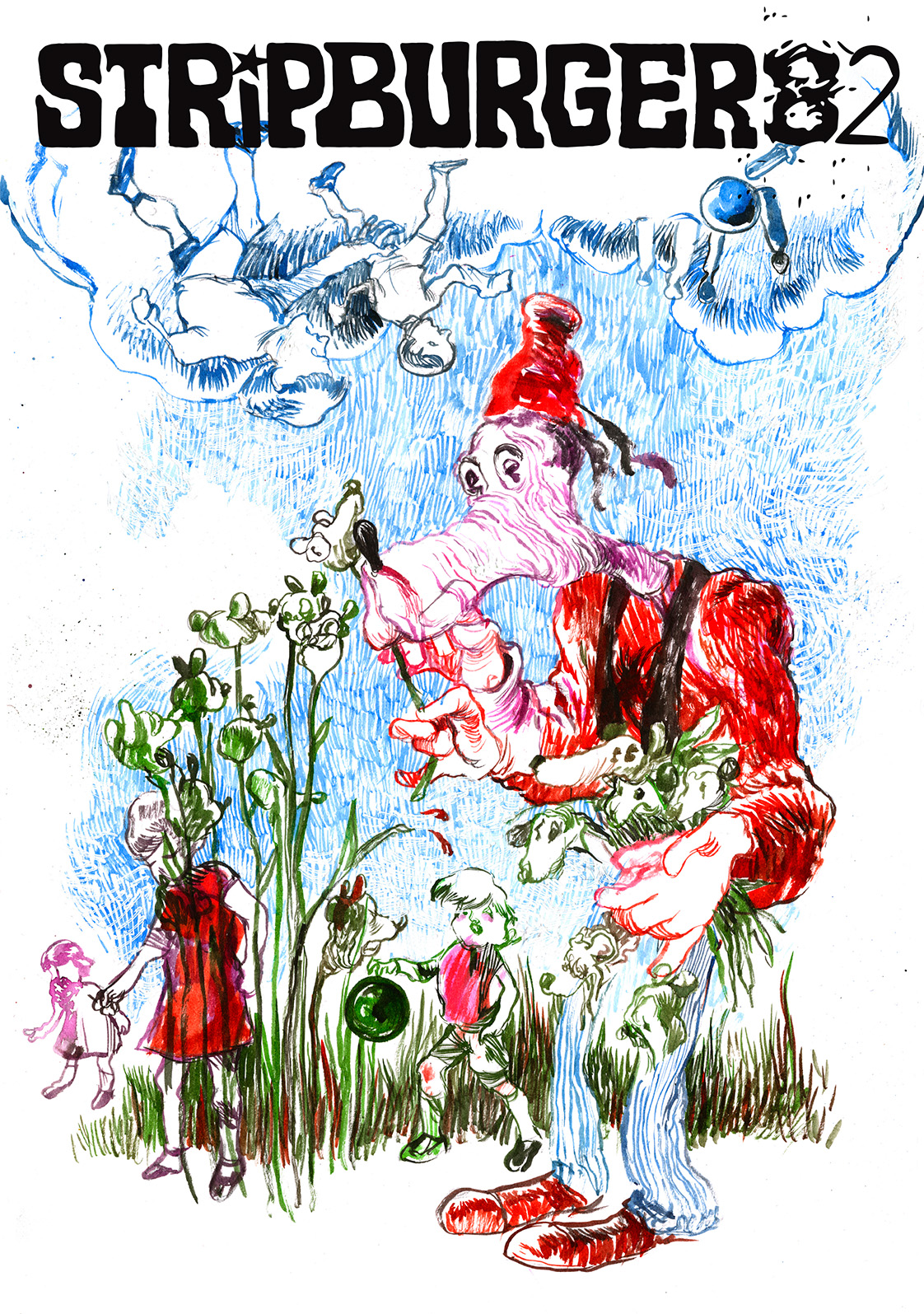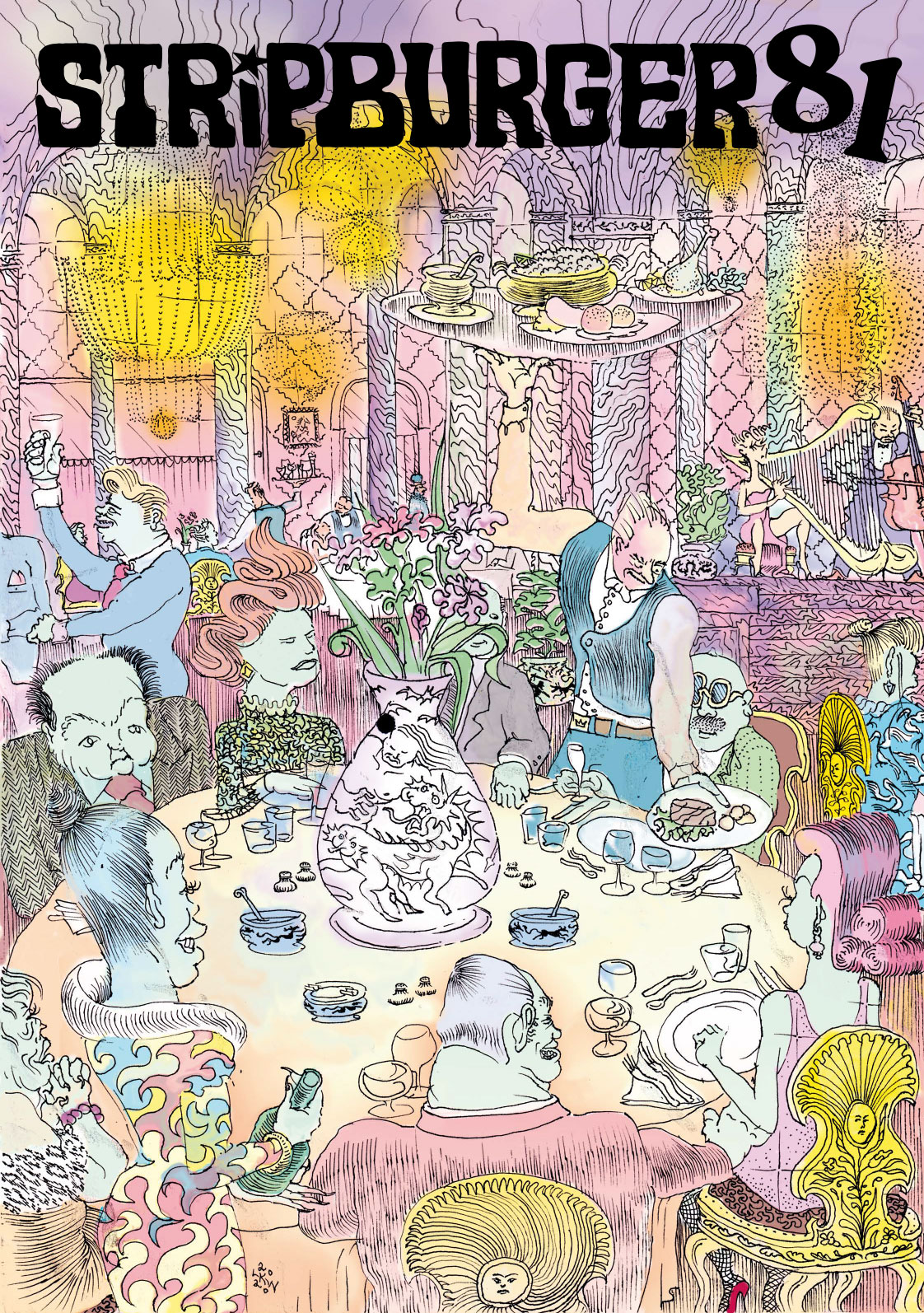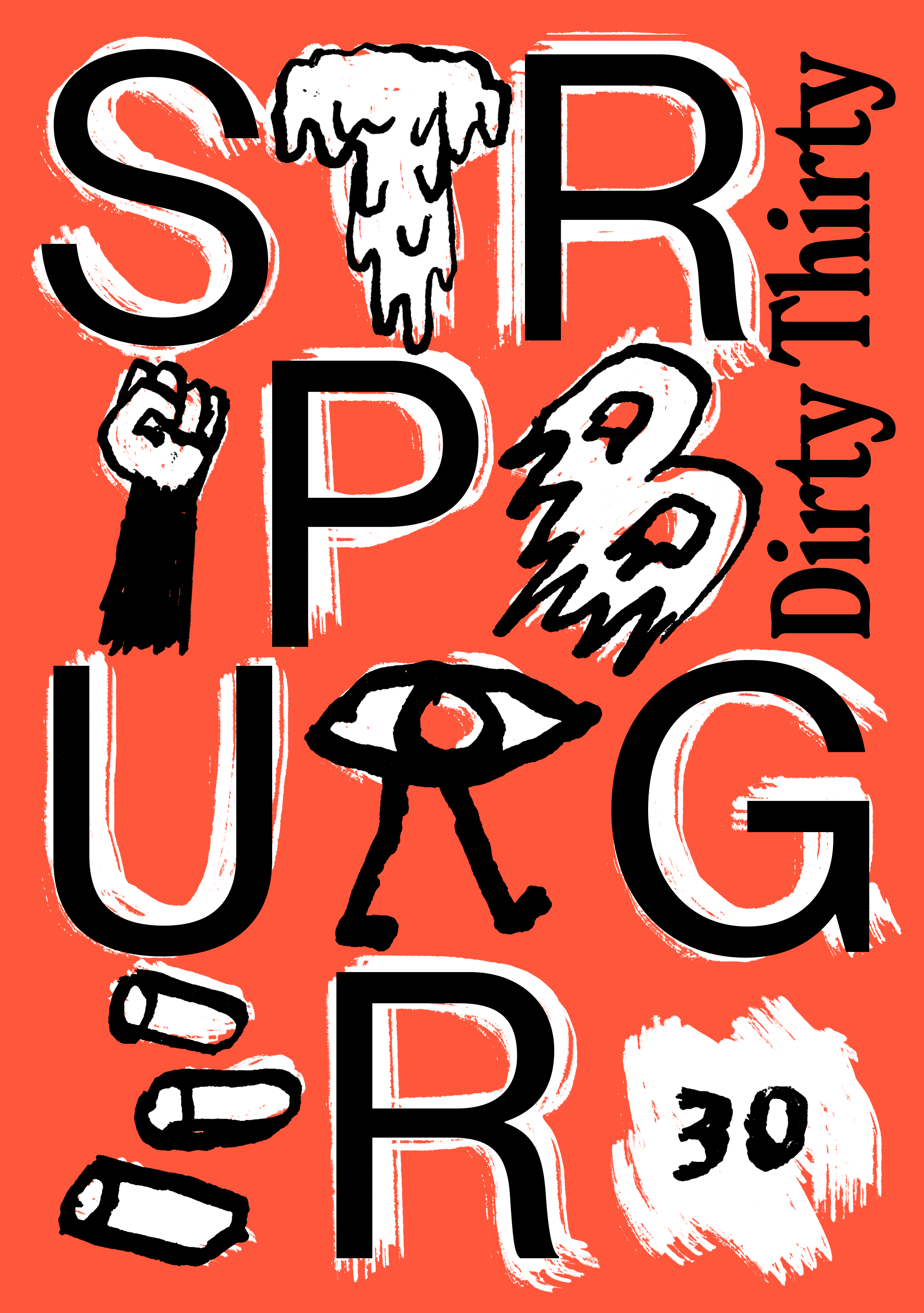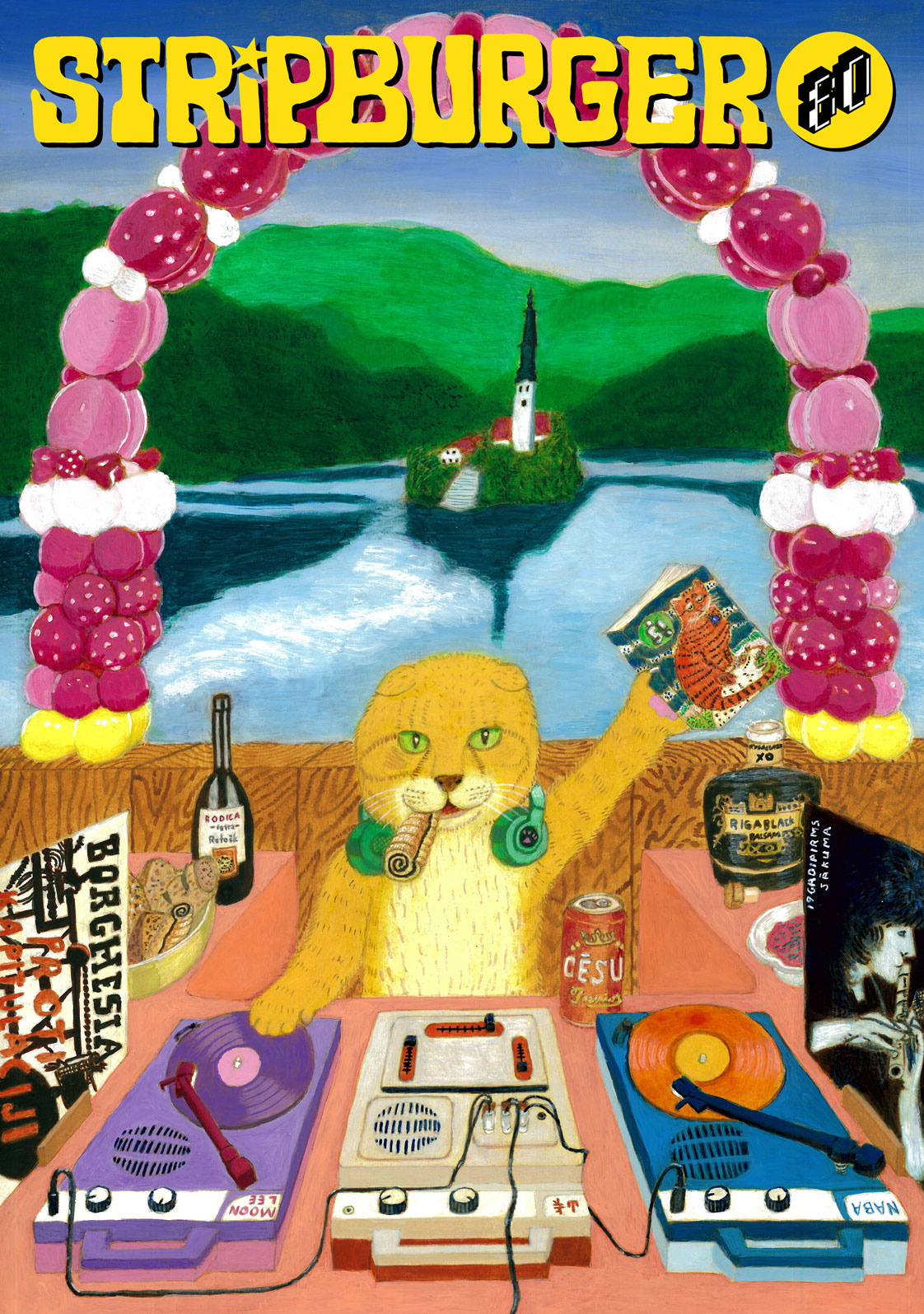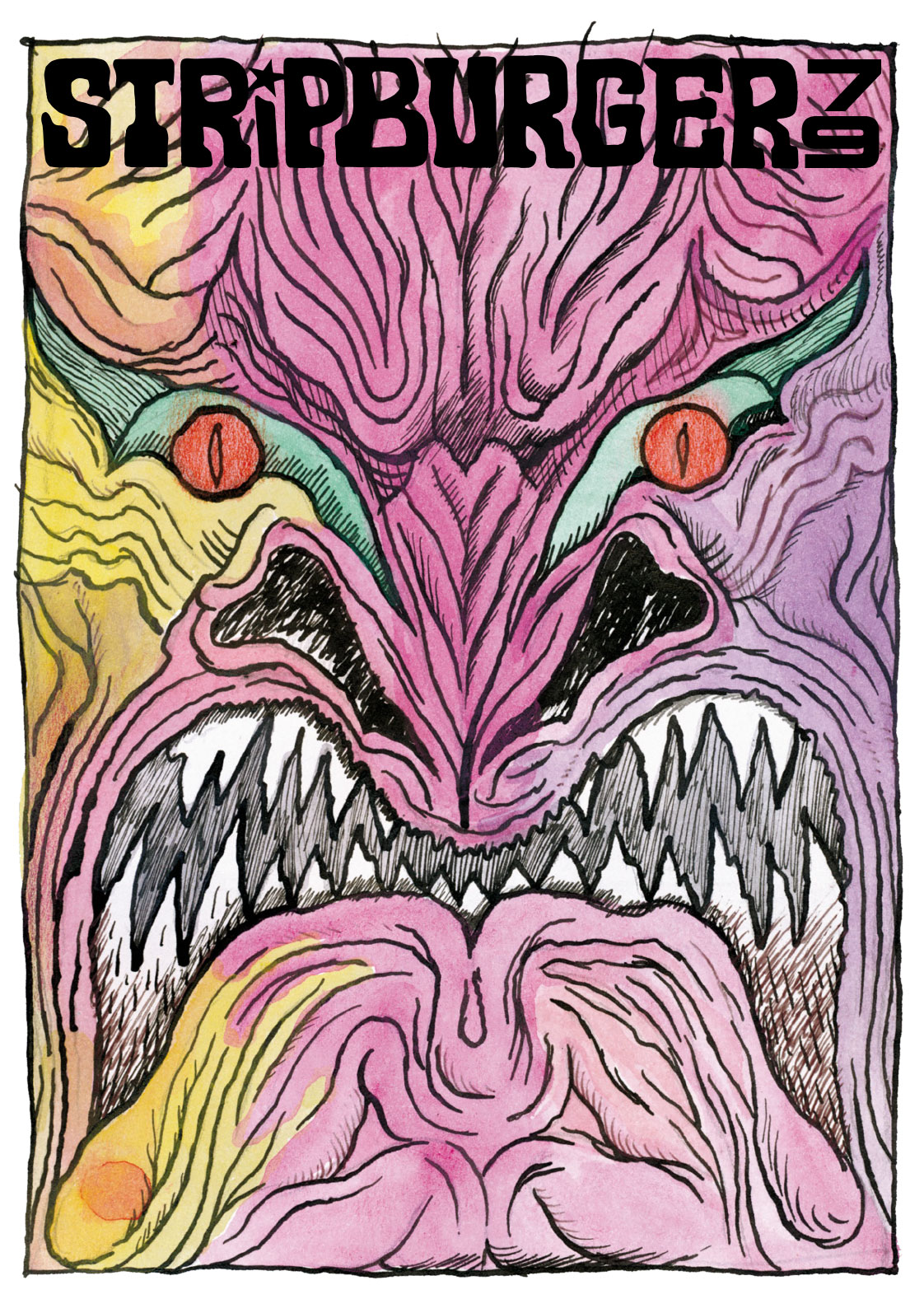Marko Kociper (Slovenia) – interview, Stripburger 64, november 2014
Kociper should be already well known to every grandma and grandpa in Slovenia. If not from elsewhere, then at least from the paper they wrap your vegetables in at the marketplace. Not that comics are often found in the contemporary Slovenian periodicals, far from that, it’s more about Marko’s ubiquity in the Slovenian media some time ago that placed him firmly at the very heights of the Parnassus of the Slovenian comics scene. We’d be exaggerating, but only a bit, if we told you there was a time when you couldn’t glance at a domestic printed page without a Badger winking at you from it or a provocative scene testing your tolerance to (in)decency.
Badger came quietly (you know what we mean) and became legendary, while its creator hasn’t been very outgoing so an average reader could only learn that he was somewhere from Gorenjska, that he likes to draw copulating characters and booze and that he holds nothing back. Even worse, Marko has been firmly in orbit around Stripburger for quite a while without being interrogated. Well, finally it’s his turn to answer the questions, kindly provided by Stripburger & friends.
You’re a member of the Slovenian Comics Hall of Fame, the exclusive group of domestic professional comic artists. When did you realise that your career path was paved in comics? Were there any special events in your life that triggered this decision? A favourite comic book or a special someone for example?
I knew already back in primary school that I only wanted to draw comics and I’ve made them since 5th grade. I took some voluntary and involuntary breaks in the meantime, mind you, but I’ve been continually making comics for the last 15 years.
When I was a kid, I used to admire the comics my uncle bought, and look over his shoulder while he was reading them. I tried to draw as well, but I wasn’t very good at it, however I did pick up some basic drawing tips from those comics. I’ve drawn since then: sometimes for an hour a day, sometimes ’till I was so tired I fell asleep. The lion’s share of my comics education was contributed by my primary school teacher of fine arts, the late academic painter Janez Hafner.
He encouraged me to enrol at the high school for design and photography in Ljubljana, but I dropped out very quickly as I was spending more time on buses and in bus stations than in school or at the drawing board. I took a long break after that and tended to family matters, but the break ended with the divorce of my now ex-wife. After that I started again to make comics, illustrations for posters etc. and matured comics-wise in Marko Brecelj’s MKC. There I broke the comics fast and made comics of a huge format – comic walls, if you like – approx. 2m by 2m. Then I got the call from Mladina magazine and that’s how my long, windy and thorny road as a comics artist actually began.
My drawing style was influenced by Richard Corben’s Mutant World, the Alan Ford series and the artists group Novi kvadrat. I used to read them all in primary school and those images became seared into my memory and helped form my current style. After that I only needed to draw, draw and then draw some more.
Were you or are you interested in anything besides comics? You’re a metal worker by education after all.
My profession is not connected to my life interests in any way. That was an emergency exit, a school you needed to finish to get a job and to make an independent living.
I’m interested in outdoor survival, in Alaska or anywhere else, but unfortunately I live in Slovenia, where even Bear Grylls couldn’t help much, and fishing as well. I love sports in general – I used to practice soccer, but I had an injury and I had to drop that. Fishing was my thing since I was a kid and last year I finally acquired the national sports fishing license.
Do you consider yourself a part of the Slovenian comics scene? You’ve drawn a good number of comic books, took part in different comic anthologies, had your comics published by Polet, Mladina, Dnevnik, not to mention all the exhibitions… What do you think of the reception of your works by the Slovenian readers? What about other comic artists?
Everyone in Slovenia is a part of the Slovenian comics scene and year after year I’m feeling increasingly part of this elite group. The reception and the reaction of the readers to my comics is OK in light of the circumstances; people have been regularly reading my comics in Mladina, Delo and Polet and commenting upon them, but it didn’t help the book sales at all. It is very important to have comics in different magazines and newspapers so that they can reach wider audiences and remain present in the collective conscience. The problem is that this wide audience does not normally buy comics publications.
Even worse, the comics have disappeared from nearly all printed media. Only Mladina remains true to it; Literatura regularly publishes comics, there is a comic strip here and there in Večer and Gorenjski glas, but that’s all.
I really hope other artists’ reception of my work is the same as mine of their work. No one really talks about or comments on anything, so, as the popular saying from the X-Files goes, “the truth is out there”. On the other hand, I’m more of a reclusive guy and I don’t hang out much with other artists…
Your first comic based on a literary work (namely by Ivan Cankar) was made in elementary school, and this connection to the literary world is still present nowadays. You’ve drawn comics after Vinko Möderndorfer’s literary works, after Andrej Rozman – Roza’s poetry and after Miha Mazzini’s short stories. Why do you like making comics based on literature? What do you think the comics form can contribute to the literary work from which it was made?
If a story is good, if it fascinates me, then I think it becomes even better if I draw it out and interpret it in the comics medium. In this way I re-create it visually and add some of my imagination to it. Social topics and marginalized individuals in Vinko’s stories are written so well that you easily get a good overview of things while the characters have distinct personal traits. It all makes these stories into great material for me to make comics from. Comics, compared to the movies, allow for more freedom with framing and allow the reader to use his or her imagination. I do draw comics about my own stories from time to time, but I prefer remaking interesting stories by others in the comics form. I’ve also made some comics inspired by the Slovenian pop songs of the 20th century.
The other characteristic of your opus is certainly eroticism. It is often quite direct, sometimes bordering on pornography. Is it a topic that sparks your creative imagination, a dick-headed visualisation of cliché male fantasies or something else completely?
In my time I used to translate porno movies, but instead of typing them out, I drew them. I found it easier to do and much more comprehensible as well.
It is a combination of both and then something else, too. It generally comes from my imagination, which turns these motives into comedy material, ensuring a happy ending! My mission as an artist is to lead my characters to a happy ending. The most fascinating thing about eroticism is the details that you can use to build up a really good situation or a story. It’s interesting because it’s part of everyday life while being taboo at the same time. It’s just like aliens: there is alien intelligence, but you can’t see it.
An interesting comics project was Hardy Hard Hotel. Could you explain to us briefly what that project was all about and maybe tell a funny anecdote connected to it?
It was supposed to be the first interactive printed comic and a parody of the first TV reality show in Slovenia. The readers were actively involved in the creative process by calling and sending texts in order to eliminate the least popular character from the comic. Once, when it was late at night, I got a call from a trucker waiting on the border crossing between Slovenia and Austria. He wanted to know the address of the hotel because he needed to relax after his long drive. Well, Hardy, the protagonist of the comic, has earned so much money with the Erotic Almanac, his previous comic, that he bought a hotel where he used to organise sex tourneys. So, this trucker wanted to take part in this competition. Hardy Hard Hotel would still be operational if politics had not interfered.
Comics are traditionally an urban medium. Your works, especially the early ones, are heavily laced with folkloric motives (the church and the tavern in the village square, the bar counter with the local drunks, a group of gossips and other village eccentrics). Have these folkloric motives disappeared with your migration from the proletarian province into the lazy capital?
I’m proud to be a representative of the indigenous provincial comics. I’ve lived in the environment that inspired these stories. A local chronicler called D’Mraz was supplying me with all these stories within my immediate vicinity. I’ve always been interested in common people’s stories. When I moved to Ljubljana, I met Vinko Möderndorfer, also a chronicler of everyday life who accurately writes about the lives of common people in the urban environment, a big city. I’m also interested in the big rights of the small people, a topic heavily present in Vinko’s stories as well.
Out of all the choices in the animal kingdom, how come you chose a badger for your main protagonist?
I’ve been wondering that myself, too. I find him interesting because he’s a mysterious guy who sleeps during the day and is active during the night, which is why we know so little about his habits of life.
Is your Badger some kind of ‘everyman’ (which means there is some of Badger in all of us) or a totally unique kind of character, a heavy individualist, a bohemian; could it stand for the artist’s alter ego perhaps? Exactly how much in the way of autobiographical elements are present in your characters?
There is something very Slovenian in my Badger, every Slovenian person has a little of Badger inside them. He’s an anti-hero, a cheat, a crook, a glutton, a rude, a sex maniac, an ingrate as well, but at the same time he’s a naïve guy who gets screwed by the same people he tried to screw over himself. His good deeds bring order into the world; he has a tender heart and a strong, hard hand (and some other hard things, too). He’s got close friends and colleagues who are blessed with more dignity and ability than he is. My characters are 70% autobiographical, the rest is a lie.
The evolution of your drawing went from fat strokes of the brush, reminiscent of the American underground comics, to the much finer lines made in pen and finally, adding a black acrylic wash. Was this a spontaneous evolution or a deliberate search for one’s own artistic expression?
The evolution of my artistic style was spontaneous. I’ve been experimenting with different drawing techniques and got most familiar with the pen. Besides wash drawings I also do colours. The majority of my comics in the last few years were actually in colour, from the autobiographical Déjà vu, the Erotični almanah, Hardy Hard Hotel till the Favna Slovenske popevke.
Your comics are made entirely by hand: you draw by hand, you fill in by hand … you don’t trust computers?
Actually I’m waiting for the computers to figure out my style, then we’ll talk.
You now have lots and lots of comics mileage behind you. How do you see your first comic books now, for example Svinjsko dobrih 8 let? Is there anything left in the comics that you’d see as a challenge? We know you’re working on the third instalment of the Badger. Where are you going? What are you doing after that?
Initially I’ve drawn according to my ability, I didn’t know any better than that. Then I started researching, drawing a lot and learned a great deal about it. All my comics show how my professional comics artist career evolved.
If you read them from the first to the last, you would be able to figure out the evolution of my style, even where I lived at a certain time and who I’d hung out with.
The biggest challenge for me would be creating a co-mic after the Pod svobodnim soncem novel, but it is such a huge challenge I haven’t got the guts to tackle it.
At this time I’m working on the concluding instalment of my trilogy Badger and the rest of the world. Badger is going to lend his character to other topics and media after the conclusion of this story; his tight body, image and voice were already featured in the Sveta jeza book. Mind you, Badger in the second part decides to live forever. You’ll be fed up with him sooner or later.
Who would win the duel between Badger and Ratman?
I think both are tired of all this fighting and would rather go on a holiday to the Island of the Dead and knock themselves out – with booze.
Is fishing your way to vent, relax and meditate when you’re sick of drawing?
No, I’m never sick of drawing. I go fishing mostly to telepathically socialise with the fish. Is there anything better than a long hot coffee and a long hot ‘fish’?
SHORT BIOGRAPHY
Marko Kociper was born in 1969 in the proletarian city of Železniki. He started producing comics at a very young age, took a long respite, then in the ’90s reappeared in Koper, where he painted huge comics murals for Marko Brecelj and finished Svinjsko dobrih 8 let, his first solo album of legendary renown. He later tempered his steel pen drawing for Polet, Delo, Dnevnik, Mladina magazine and other periodicals, while his other comics and comic books were being published with our publishing house. He’s become a passionate fisherman lately. He’ll never admit being a bigger badger than Badger.
BIBLIOGRAPHY:
Jazbec in otok mrtvih, Stripburger/Forum Ljubljana, 2014
Sveta jeza (w/ Vinko Möderndorfer), Stripburger/Forum Ljubljana, 2012
Strip je že v redu mama (w/ A. Rozman – Roza), Stripburger/Forum Ljubljana, 2010
Jazbec in ostali svet, Stripburger/Forum Ljubljana, 2009
Dika, Stripburger/Forum Ljubljana, 2005
Podgana, Stripburger/Forum Ljubljana, 2002
Svinjsko dobrih 8 let, DPZN, 1999

